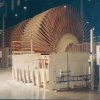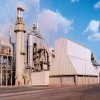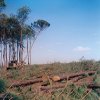Bucking the trend
20 August 2005At a time when Brazilian particleboard makers have been reluctant to boost production capacity in an uncertain market, leading panel producer Satipel Industrial SA has quietly continued expanding.
Successfully raising the output of its 1,000m3/day Siempelkamp ContiRoll line in Uberaba by 30% through de-bottlenecking in 2003, Satipel is preparing now to extend the main press to take annual capacity from 430,000m3/year to nearly 700,000m3.
Meanwhile, the company is reinforcing its presence in Brazil’s all-important southern marketplace where, in Taquari, Rio Grande do Sul state, it runs a 35-year-old 200,000m3/year batch press line.
In a battle to compete with Brazil’s more modern continuous press lines, Satipel is spending around US$2m to boost panel quality and lower manufacturing costs. Just as wood prices are soaring, it has modified the line to accept sawmill residues, and is upgrading dry fibre screening and panel sanding to improve product finish.
Beyond this, Satipel is also making a preliminary study of “the logical next stepfor Taquari – the introduction of continuous press technology. The firm is considering a low-cost, two-phase option which would eventually lift capacity to 350,000m3/year, revealed operations vice president Mauro Pini França.
With board demand set to rise further in the south, such a move may be feasible in less than three years’ time, he said. “We are following carefully forecasts and trends in the market, and when it seems a good time to go further on the process, we will do it,Mr França said guardedly.
Back in Uberaba, when Satipel launched its first continuous line in 2000, underpinned by a big wood resource of more than 40,000ha of planted pine forest, a press extension to 1,500m3/day was already planned. But much of the line, apart from woodyard units, needs upgrading to accommodate the extra output.
Following strong growth in the particleboard market last year, with sales rising 14%, Satipel plans to extend the ContiRoll press from 25.5m to 38.7m in 2006. The plant has six weeks downtime programmed for next January and February, traditionally the quietest period of the market year.
Major modifications needed to support the extra capacity include installation of a second dryer; the upgrade of the energy plant to feed the dryer with hot gas and some strengthening of the fibre preparation area. That means the addition of a fifth ring flaker, a fourth screen, and a fourth mill to refine material for the board’s surface layer.
In the line’s resin preparation area, the company needs to make changes too. It is due to switch the core layer blender to the surface layer position and replace it with a new, larger blender for the core layer.
Downstream also, Satipel has to make changes, adding another pair of sanding heads to its six-head sanding line to increase the speed and process the extra board volume, according to the vice president, interviewed at Satipel’s Uberaba facility in May.
Investment appears relatively modest for the line expansion at a likely US$15m. “Considering the extra capacity you get – roughly 200,000m3/year – it is not a high investment overall,he observed, admitting the initial line investment was obviously a bit higher but “is now paying off”.
Satipel originally launched its continuous particleboard line in 2000 as part of a major expansion project in western Minas Gerais state. Previously, the firm produced particleboard in Uberaba on two old batch lines, one a single-opening press unit and the other a five-daylight press line, with a combined 160,000m3/year capacity.
In readiness for the ContiRoll press extension, as well as to help build up its market share, Satipel has brought its old 300m3/day multi-opening press back into service. The Siempelkamp-built press was mothballed three years ago as the continuous line got started, but was reconditioned and began running again this April.
With its electrical and electronic systems earlier modernised, the old line is set to move centre-stage once again as it takes the strain through the downtime period. The plant also plans to build up panel inventory to sustain its customers at that time.
In 2003, Satipel led the field among Brazil’s particleboard producers with a 23% share of national production capacity.With no major new capacity projects planned for particleboard since then, it has maintained its leadership. No new capacity is likely in the next two years, said Mr França.
The firm is predicting new market growth during 2005 of between 10%-12% for its panel in Brazil. It believes it is well placed to feed further particleboard demand, if necessary, by still running its old machine alongside the expanded ContiRoll line.
One project by panel newcomer Fibraplac SA of Porto Alegre to build a 330,000m3/ year particleboard line alongside its MDF plant in southern Brazil was recently dropped in favour of a second line for MDF.
But, producing particleboard in Brazil has not all been plain sailing. Panel makers are having to come to terms with a down side to the new boom in Brazil’s furniture industry. In recent years, economic growth in Brazil has tempted many more people from the country’s poorer ‘C’ class to enter the furniture market for the first time.
While their arrival has certainly stimulated new growth in the sector, it has also fuelled a drive by furniture manufacturers to make even cheaper products to fit limited consumer budgets. This, in turn has hit the laminated panel market with furniture makers opting to run board printing/painting lines themselves instead of buying melamine or finish foil faced board. Panel makers’ margins have been slashed as sales of their value added products have plummeted.
“It’s not only our concern, but also that of our competitors because probably more than 50% of Brazil’s furniture companies today use raw boards to paint themselves,said Mr França. Satipel is running at barely 70% of capacity in both melamine and finish foil laminated board, he admitted. Melamine board sales in Brazil overall were down by almost 13% in 2004.
But he forecast the practice among furniture firms will eventually backfire. Difficulties in colour matching components and frustration over poor productivity when pieces have to be returned for repainting should bring them back into the laminate fold, predicted the vice president. Meanwhile, “we have to dance according to the musicand deliver just raw board, he added.
Satipel’s decision to invest US$220m in the north central state of Minas Gerais came primarily from the huge wood potential of more than 50,000ha of concentrated forest land it bought in 1998 near Uberaba.
At a time of escalating wood prices, Satipel’s Uberaba mill is in the enviable position of complete self sufficiency in raw material. From this, the firm estimates it saves up to 30% on its production costs today, according to Mr França. Two-thirds of the one million m3 of solid wood it harvests annually goes to the plant, with the rest sold either to sawmills, energy use or chipping.
With an eye on costs, the panel maker is rapidly switching from tropical pine to highyield eucalyptus plantation. In the larger of two properties it is harvesting mature trees from a 38,500ha pine forest and has already planted 8,000ha of eucalyptus there.
From 2007, the proportion of eucalypt used in the Uberaba board will begin to rise and, by 2011 or 2012, it expects to be 100% eucalypt based, predicted Mr França. In the constant fight to be the lowest-cost panel producer, an estimated jump in wood yield of around 40% must be worth achieving.



